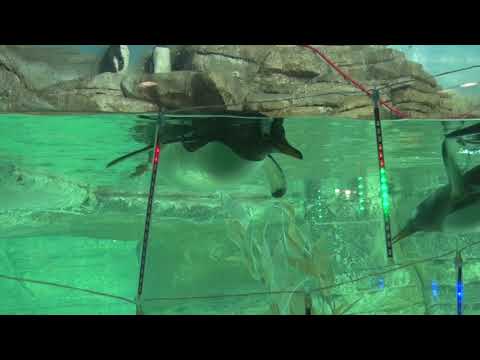- Understanding sensory enrichment: Its significance and impact on Gentoo Penguins.
- Observations on Gentoo Penguins’ natural behaviors and habitat needs.
- Implementation of creative enrichment programs in zoos.
- The role of sensory enrichment in wildlife conservation and public education.
- Ethical considerations and challenges in developing enrichment strategies for Gentoo Penguins.
Gentoo penguins, with their distinctive markings and curious nature, are fascinating creatures that demand thoughtful care, particularly when kept in zoos. Sensory enrichment plays a pivotal role in their well-being. This practice involves carefully orchestrated activities and environments that stimulate an animal’s senses and encourage natural behavior, vital for healthy physical and psychological states. For Gentoo Penguins, who possess acute auditory, olfactory, and tactile senses, sensory enrichment is critical. Enhancing their captive environment aids in mimicking natural conditions, contributing positively to their health and making it possible for these birds to thrive.
Experts in zoology and zoo management have gathered substantial evidence demonstrating the effectiveness of sensory enrichment on penguins. These practices engage the penguins’ curiosity and problem-solving skills. For instance, varying textures, sounds, and scents engage their senses in ways that mirror their natural habitats. Changing water levels and adding ice chunks simulate the penguins’ dynamic environments, promoting natural foraging behaviors and boosting their physical activity. By fostering engagement, sensory enrichment encourages penguins to interact with their surroundings similarly to how they would in the wild, crucial for their overall health.
Observing the natural behaviors of Gentoo Penguins provides insight into their enrichment needs. In the wild, they are often found on sub-Antarctic islands, requiring cold, aquatic environments. They rely heavily on their senses to navigate and forage, interacting with ever-shifting sea ice and varying ocean conditions. In captivity, enrichment must be geared towards replicating these conditions. Enticing sensory experiences like water sprays, varying air currents, and periodic temperature changes can serve to simulate the chilling breezes of their natural habitats, keeping the Gentoo active and engaged, and catering to their evolutionary adaptations.
At modern zoos, implementing creative and practical enrichment programs involves a myriad of strategies to support the Gentoo Penguins’ sensory well-being. Zoo personnel embed enrichment into the daily routines of Gentoo Penguins, maintaining an interactive environment that stimulates their senses and provides mental stimulation. Regularly rotated features like floating platforms and play-based foraging activities can mimic environmental changes and challenges faced by wild penguins. Educational initiatives often involve creating ice floes in exhibit pools, scattering food to encourage natural foraging behavior, and utilizing lights and sounds that mimic the aurora or ocean waves. Through such detailed enrichment strategies, zoos can simulate natural environments that keep Gentoo Penguins physically and psychologically active, promoting welfare and facilitating educational outreach.
The role of sensory enrichment extends beyond individual wellness and taps into broader wildlife conservation efforts. Zoos play a dual role in public education and species conservation, leveraging enrichment strategies as tools for awareness. By showcasing the unique adaptations and behaviors of Gentoo Penguins, enriched environments serve as interactive educational platforms that highlight conservation challenges these penguins face in the wild. Sensory enrichment not only facilitates the Penguins’ physical and mental health but empowers zoos to engage the public in meaningful dialogues about habitat degradation, climate change, and conservation efforts. This multifaceted approach ensures that zoos become pivotal spaces poised to influence public perception and advocate for species preservation.
However, ethical considerations and challenges exist in developing enrichment strategies for Gentoo Penguins, demanding ongoing reflection and responsibility from zoo staff. Creating authentic sensory experiences requires collaboration between veterinarians, biologists, and behavioral experts, underscoring the necessity of interdisciplinary expertise. Zoos must take care to avoid overstimulation, recognizing the fine line between beneficial enrichment and sensory overload. It becomes essential to customize enrichment to suit the individual needs of the penguin, taking into account factors like their age, health, and reproductive status. Furthermore, the sustainability and environmental impact of enrichment materials and techniques must be considered alongside welfare benefits, reinforcing a holistic commitment to ethical zoo practices.
Incorporating sensory enrichment into the care of Gentoo Penguins showcases an advanced understanding of animal welfare. By providing environments that simulate natural conditions, zoos can support healthy and psychologically fit penguin populations. Sensory enrichment serves as both a conservation tool and an educational opportunity, demonstrating its myriad benefits beyond immediate animal husbandry. It represents a commitment to humane and reflective management practices that honor the complexity and sentience of Gentoo Penguins. Through progressive enrichment programs, the welfare of Gentoo Penguins in zoos can be substantially elevated, efficiently merging scientific inquiry with public engagement and ensuring a profound appreciation for wildlife conservation.
*****
Source Description
In their natural range, the gentoo penguins would spend most of their time at sea. Unique lighting on the habitat pool walls is a form of sensory enrichment, providing visual opportunities that spark their natural curiosity and encourage the flock to swim.


